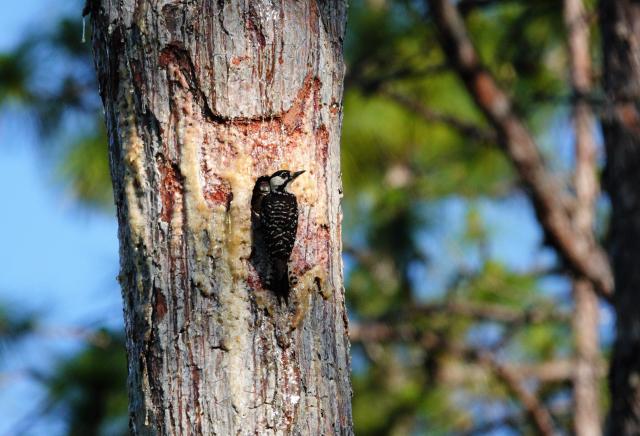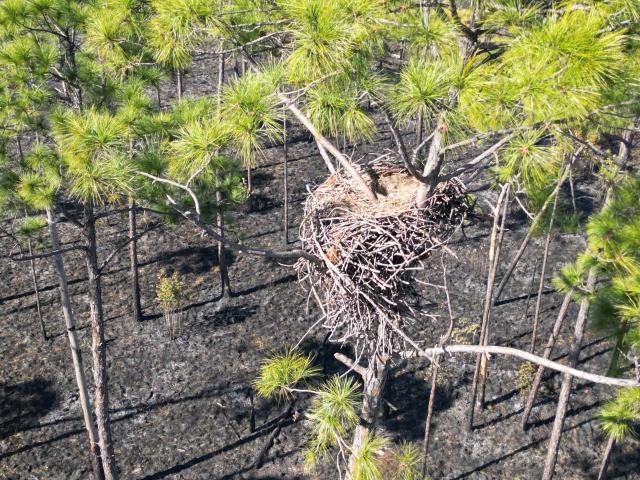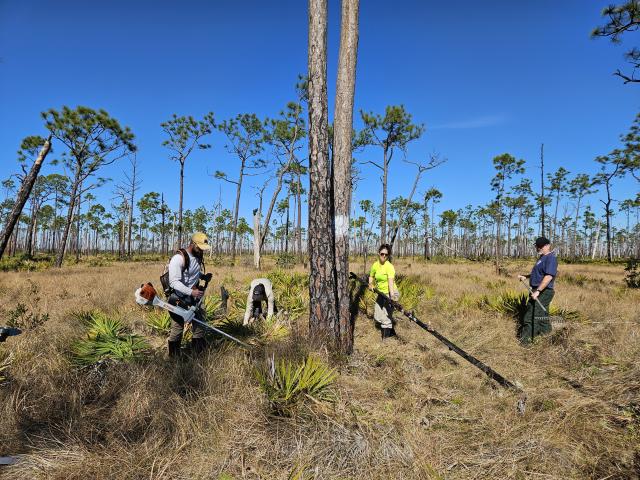In Florida, BLM, U.S. Fish & Wildlife Service use fire to save an endangered woodpecker
Listen
Subscribe
Related Content
In 2018, a Category 5 hurricane blasted through Lathrop Bayou in the Florida Panhandle, knocking down trees and leaving a huge path of destruction. A few years later, specialists on a field trip noted that a very small population of red-cockaded woodpeckers, which are on the Endangered Species List, were alive on the Bayou's small peninsula. In February 2024, BLM and U.S. Fish & Wildlife Service specialists conducted a prescribed burn on the peninsula with the intent to rejuvenate the landscape and make it more favorable to the woodpeckers and other wildlife species who live there. In this episode, we interview Bart Kicklighter, State Fire Management Officer for BLM's Eastern States State Office.
Transcript
NARRATOR (David Howell, Senior Communications Specialist): While the Bureau of Land Management is seen mostly as a western agency, it also has scattered parcels of land throughout the Eastern United States. Some of these small tracts of land are vital to the health of threatened and endangered species.
I’m David Howell, and you’re listening to “On The Ground: A Bureau of Land Management Podcast.’ Bart Kicklighter is the BLM’s Eastern States Fire Management Officer. Last year, BLM received $50,000 from the Bipartisan Infrastructure Law to implement a project at Lathrop Bayou in northern Florida. The project is aimed at recovering the red-cockaded woodpecker, which is protected under the Endangered Species Act. Scientists knew of a small population at this particular location, but thought that it had been wiped out in a massive hurricane in 2018. A few years later, they got a bit of a pleasant surprise.
BART KICKLIGHTER (State Fire Management Officer, BLM Eastern States State Office): Lathrop Bayou is in the Panhandle just east of Panama City, Florida. This special little piece of land, it’s a peninsula. It's almost an island except for this marsh grass area that separates it from the upland. BLM manages 194 acres of this peninsula, and there's another piece that's owned by two private entities and they have about 367 acres. So it's a combined total of 561 acres of peninsula, a wiregrass/longleaf pine ecosystem that's just a very rare piece because of its being surrounded by water here.
HOWELL: What's the nature of the project? What were we trying to accomplish? Because I know, I think this is something that you guys implemented back during the wintertime, if I remember.
KICKLIGHTER: We conducted a prescribed burn in February (2024). We also did this four years ago in 2020. This whole area was hit by a Category 5 Hurricane, Hurricane Michael in 2018. And so, when I moved here to this position three years ago (2021), the general consensus of this area was that there was nothing left on the Lathrop Bayou property; Hurricane Michael knocked down every tree; it was just, you know, a thick stack of dead trees on top of each other and nothing was there.
So, we decided to take a field trip out there in 2023, and look around, and of course, we found red-cockaded woodpeckers alive and well! Not very many, but was definitely a surprise. And then a little more walking around, and we found plenty long leaf pine trees still standing with cavities that were actively being used by red-cockaded woodpeckers. So it was a it was a great surprise to see this and gave us even more fuel to want to get out there and start making sure this habitat was restored and kept maintained.
HOWELL: OK, so that I didn't know. I knew that the red-cockaded woodpeckers are on the endangered species list, but I didn't know that it was, kind of, hiding?
KICKLIGHTER: On this piece, hiding because it's such a hard place to get to. You basically have to have a boat or some really high waders if you want to hike through some really thick reeds and grass to get out there, but probably doesn't get very much visitation just because of its location. It's a relatively small peninsula and yeah, not a lot there, but pine trees and some shrubs and grass. But there are some threatened endangered plants there as well. There's two bald eagle nests that are active in the area, so it's quite a little treasure.
HOWELL: One of the first stories that we did for this podcast actually was a prescribed burn out of Colorado. And from your perspective as a fire management officer, what do prescribed fires do in terms of, I don't know, helping to build the habitat or -- sometimes I've heard, they kind of help clean up the vegetation. In this particular case, what's it trying to do?
KICKLIGHTER: Yeah, the number one advantage to prescribe fire is to reduce the hazardous fuels and any of the dead and down logs, brush, things that just build up and make it kind of messy. Think about a place that's hard to walk through and then you have a good, controlled burn through there. It cleans up all that brush and dead sticks and trees. That makes it easier to walk through for us, makes it easier to travel through for species like deer, turtles, tortoises, if they're in the area.
And then of course it regenerates, it adds nutrients back to the soil from the burned vegetation, promoting more growth of small herbaceous shrubs, things that turtles and other small animals eat. So it's regenerating food for small animals and mammals. And then creating that open habitat, which is something that the woodpeckers seem to prefer.
HOWELL: So they want the big open spaces, then. They're not looking for an enclosed forest.
KICKLIGHTER: Right. If you look at the research and look at the larger tracts of forests that have bunches of woodpeckers versus what we have here -- a tiny population -- you'll see that the birds flourish in the wide-open areas. And then when you find the areas that are more choked up with vegetation and lack of fire, the birds aren't there. They're nearby, but not in the thick, thick brush and vegetation.
HOWELL: Interesting. So I know that we're not the only ones out there doing this. We have a partner in on this project.
KICKLIGHTER: We had several on this project. The U.S. Fish and Wildlife Service has offices very close to this and have biologists there that are also super keen on recovering the red-cockaded woodpecker populations. And so, the Fish and Wildlife Service there in Panama City; they also have some employees at work there at the nearby Tyndall Air Force Base. And then we have the St. Marks National Wildlife Refuge just south of Tallahassee, and they had some folks come over and help us with some equipment. They have what's called a marsh master. It's looks like basically a small tank on tracks that was able to mash down the marsh grass in between the burn unit and the area we did not want to burn. So we didn't have to basically put any kind of dozer line or any more destructive lines in there.
HOWELL: Ah, OK. So instead of instead of, instead of removing the vegetation, just tramp it down there.
KICKLIGHTER: Tramp it down. It will of course, come back after we leave. And then one of the biggest partners for us is a BLM partner from out in Colorado. We have… The Unaweep Wildland Fire Module came to help us out, and they brought with them drones. So the majority of this island and peninsula was burned from the air via an unmanned drone, dropping spheres that ignite once they hit the ground.
HOWELL: Oh, I've heard of that technology! Back when I worked in Idaho, I think that there was a little bit of a demonstration. It was very, very new at the time. But they're kind of like ping pong balls or something that you drop from drop from a height?
KICKLIGHTER: Yep. They're about the size…a little smaller than a ping pong ball. And right before they're released from the machine they're injected with antifreeze -- glycol -- and that creates a chemical reaction that takes a few seconds. And so by the time the small spheres hit the ground, they kind of burst into a small open flame and hopefully they land into some receptive dry fuel and start individual small fires that all grow together. And it keeps us out on boats watching it and not getting in close to the fire.
HOWELL: Yeah, I was going to say it's a little bit of a safety factor there, then, for your firefighters.
KICKLIGHTER: Huge. It's a huge development in technology that's very welcomed.
HOWELL: Last question really, and it's more along the lines of how you got involved into this: you mentioned that you're from the local area, and I'm just guessing, but you probably didn't start your career with BLM.
KICKLIGHTER: I did not. I started with the US Forest Service in the Panhandle of Florida, graduating from Florida State University and then working nearby there on the Apalachicola National Forest, which I believe has the largest population of red-cockaded woodpeckers. So that's where I got where I got my start was in Graduate School working with these birds, following them, banding the young, all those things. And then moved into fire management with the Forest Service. And then 20 years later switched over to BLM here in the East, and when I found out there was possibility of red-cockaded woodpeckers on BLM land, of course I was super excited and itching to go out and check it out.
HOWELL: Yeah, clearly -- I mean, this has been something that you've been following your whole career.
KICKLIGHTER: Right. So I'm hopeful that this this population will continue to exist and maybe grow a little bit with our help of keeping the vegetation in check just like they like it.
HOWELL: Bart, thank you so much. This is it's been really, really helpful for me and I appreciate you taking a little bit of time out of your day to come and talk to me about it.
KICKLIGHTER: For sure!
NARRATOR (HOWELL): Bart Kicklighter is the State Fire Management Officer for BLM’s Eastern States State Office. He spoke with us from his office just outside of Jackson, Mississippi.
If you’d like to see what a red-cockaded woodpecker looks like or see pictures of the prescribed burn in operation, you can go over to our website on BLM.gov/media/podcasts, or Google Bureau of Land Management podcasts.
We are now on iTunes, and we are uploading all of our episodes to that platform, so if you like what you hear, please follow us on that channel.
I’m David Howell – thanks for joining me! And we’ll see you out there, “On The Ground.”






